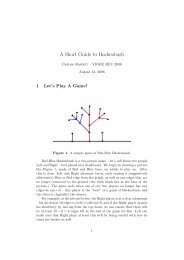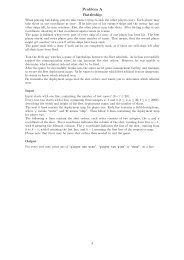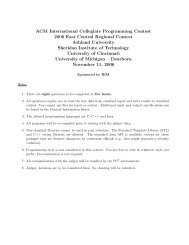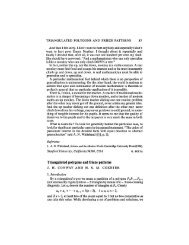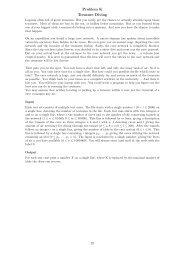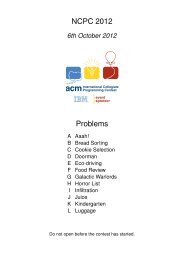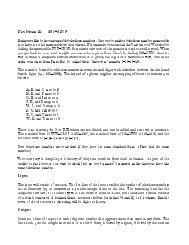Review1 of Liber De Ludo Aleae (Book on Games of Chance) by ...
Review1 of Liber De Ludo Aleae (Book on Games of Chance) by ...
Review1 of Liber De Ludo Aleae (Book on Games of Chance) by ...
Create successful ePaper yourself
Turn your PDF publications into a flip-book with our unique Google optimized e-Paper software.
Pro<str<strong>on</strong>g>of</str<strong>on</strong>g> <str<strong>on</strong>g>of</str<strong>on</strong>g> Lemma5<br />
According to Lemma 4, as n becomes infinitely large, M / Ln becomes<br />
infinite, then the ratios L1 / Ln+1 , L2 / Ln+2, L3 / Ln+3 become all the more<br />
infinite. So it then follows that:<br />
that is, the sum <str<strong>on</strong>g>of</str<strong>on</strong>g> the terms between M and Ln is infinitely greater than<br />
the sum <str<strong>on</strong>g>of</str<strong>on</strong>g> the terms left <str<strong>on</strong>g>of</str<strong>on</strong>g> Ln. Since <strong>by</strong> Lemma 1 the number <str<strong>on</strong>g>of</str<strong>on</strong>g> terms<br />
left <str<strong>on</strong>g>of</str<strong>on</strong>g> Ln exceeds the terms between Ln and M <strong>by</strong> <strong>on</strong>ly (s-1) times (that is,<br />
a finite number <str<strong>on</strong>g>of</str<strong>on</strong>g> times), and then from Lemma 3 the terms become<br />
smaller more distant from Ln, then (the sum <str<strong>on</strong>g>of</str<strong>on</strong>g>) all the terms between Ln<br />
and M (even if M is not included) will be infinitely larger than (the sum)<br />
left <str<strong>on</strong>g>of</str<strong>on</strong>g> Ln. In the same way ... [for the right side]<br />
The Propositi<strong>on</strong> is then stated as:<br />
Let the number <str<strong>on</strong>g>of</str<strong>on</strong>g> favourable cases to the number <str<strong>on</strong>g>of</str<strong>on</strong>g> unfavourable cases be exactly or<br />
nearly r/s, therefore to all the cases as r/r+s = r/t - if r+s = t - this last ratio is between<br />
r+1/t and r-1/t. We can show, as many observati<strong>on</strong>s can be taken that it becomes more<br />
probable arbitrarily <str<strong>on</strong>g>of</str<strong>on</strong>g>ten (for example, c - times) that the ratio <str<strong>on</strong>g>of</str<strong>on</strong>g> favourable to all<br />
observati<strong>on</strong>s lies in the range with boundaries r+1/t and r-1/t.<br />
Bernoulli observes that given a probability r/t for a favourable outcome, and a probability s/t for an<br />
unfavourable outcome, in nt trials (with t = r+s), the number <str<strong>on</strong>g>of</str<strong>on</strong>g> (possible) events with all favourable<br />
outcomes, all but <strong>on</strong>e favourable outcomes, all but two favourable outcomes, etc. are<br />
nt<br />
r ,<br />
nt ⎞ nt−1<br />
⎟r<br />
s<br />
⎛<br />
⎜<br />
⎝1<br />
⎠<br />
,<br />
L<br />
L + L + L + ...<br />
+ L<br />
1<br />
+ L<br />
nt ⎞ nt−2<br />
2<br />
⎟r<br />
s<br />
⎛<br />
⎜<br />
⎝2<br />
⎠<br />
2<br />
+ L<br />
,<br />
3<br />
+ ... + L<br />
n+<br />
1 n+<br />
2 n+<br />
3<br />
2n<br />
These corresp<strong>on</strong>d to the terms in the expansi<strong>on</strong> <str<strong>on</strong>g>of</str<strong>on</strong>g> r+s, for which a number <str<strong>on</strong>g>of</str<strong>on</strong>g> useful properties were<br />
established in the lemmas. First, the number <str<strong>on</strong>g>of</str<strong>on</strong>g> trials with nr favourable outcomes and ns unfavourable<br />
outcomes is M. Next, the number <str<strong>on</strong>g>of</str<strong>on</strong>g> trials with at least nr-n and at most nr+n favourable outcomes is the<br />
sum <str<strong>on</strong>g>of</str<strong>on</strong>g> terms between the two limits Ln and Rn defined in Lemma 4. Bernoulli can then write:<br />
Since the binomial exp<strong>on</strong>ent can be selected so large that the sum <str<strong>on</strong>g>of</str<strong>on</strong>g><br />
terms which are between both bounds Ln and Rn is more than c times the<br />
sum <str<strong>on</strong>g>of</str<strong>on</strong>g> all the remaining terms outside <str<strong>on</strong>g>of</str<strong>on</strong>g> these bounds, (from Lemmas 4<br />
and 5), it follows then that the number <str<strong>on</strong>g>of</str<strong>on</strong>g> observati<strong>on</strong>s can be taken so<br />
large that the number <str<strong>on</strong>g>of</str<strong>on</strong>g> trials in which the ratio <str<strong>on</strong>g>of</str<strong>on</strong>g> the number <str<strong>on</strong>g>of</str<strong>on</strong>g><br />
favourable cases to all cases will not cross over the bounds (nr+n)/nt<br />
and (nr-n)/nt or (r+1)/t and (r-1)/t, is more than c times the remaining<br />
cases, that is, that it is more than c times probable that the ratio <str<strong>on</strong>g>of</str<strong>on</strong>g> the<br />
26<br />
n<br />
= ∞




